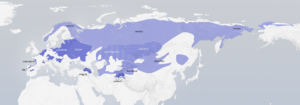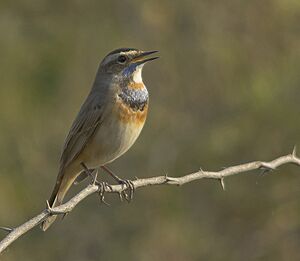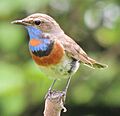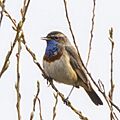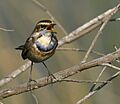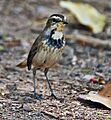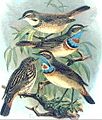Bluethroat facts for kids
Quick facts for kids Bluethroat |
|
|---|---|
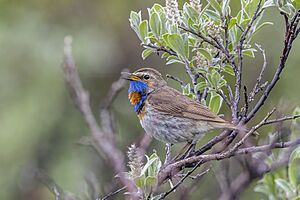 |
|
| L. s. svecica, Oppdal, Norway | |
| Conservation status | |
| Scientific classification | |
| Genus: |
Luscinia
|
| Species: |
svecica
|
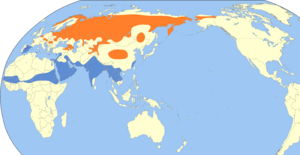 |
|
| Distribution of the bluethroat (orange: breeding range; blue: non-breeding range) | |
The bluethroat (Luscinia svecica) is a small bird known for its beautiful song. It belongs to a group of birds called passerines, which are often called "perching birds." It used to be considered a type of thrush, but now scientists think it's more like an Old World flycatcher. Smaller European birds like the bluethroat are sometimes called chats.
This bird is a migratory species, meaning it travels long distances between its breeding and wintering grounds. It eats mostly insects. Bluethroats breed in wet areas with birch trees or bushy swamps across Europe and Asia, and even in parts of western Alaska. They build their nests in grassy clumps or low, dense bushes. When winter comes, they fly south to places like the Iberian Peninsula (Spain and Portugal), the northern half of Africa, and southern Asia, including the Indian subcontinent.
The bluethroat is about the same size as a European robin, measuring around 13–14 centimeters (about 5 inches) long. Its back is plain brown, but its tail is special: it's black with bright red patches on the sides. It also has a clear white stripe above its eye, called a supercilium. Even though male bluethroats can look quite different from each other, recent studies of their DNA show that they are all part of the same species. Bluethroats change their feathers (this is called moulting) after breeding, starting in July. This process takes about 40–45 days, and then they are ready for their long migration.
The male bluethroat has a very varied and impressive song. It can even imitate the songs of other birds! Its usual call sounds like a typical "chat" noise, a sharp chack.
Bluethroat Subspecies
There are different types, or subspecies, of bluethroats. These groups have slight differences, often in their appearance or where they live.
Female bluethroats, no matter which subspecies they belong to, usually have a cream-colored throat and chest with just a blackish crescent shape on it. Young bluethroats, who have just learned to fly, are spotted and freckled with dark brown on their backs.
What's in a Name?
The scientific name for the bluethroat is Luscinia svecica. The first part, Luscinia, comes from Latin and is also the name for the common nightingale. The second part, svecica, comes from a newer form of Latin, Suecicus, which means "Swedish."
People thought the colors on the male bluethroat's chest looked like the Swedish flag. In the 17th and 18th centuries, the yellow on the Swedish flag was more orange, which matched the bird's colors even better.
Images for kids
-
Female at Keoladeo National Park, Bharatpur, Rajasthan, India



